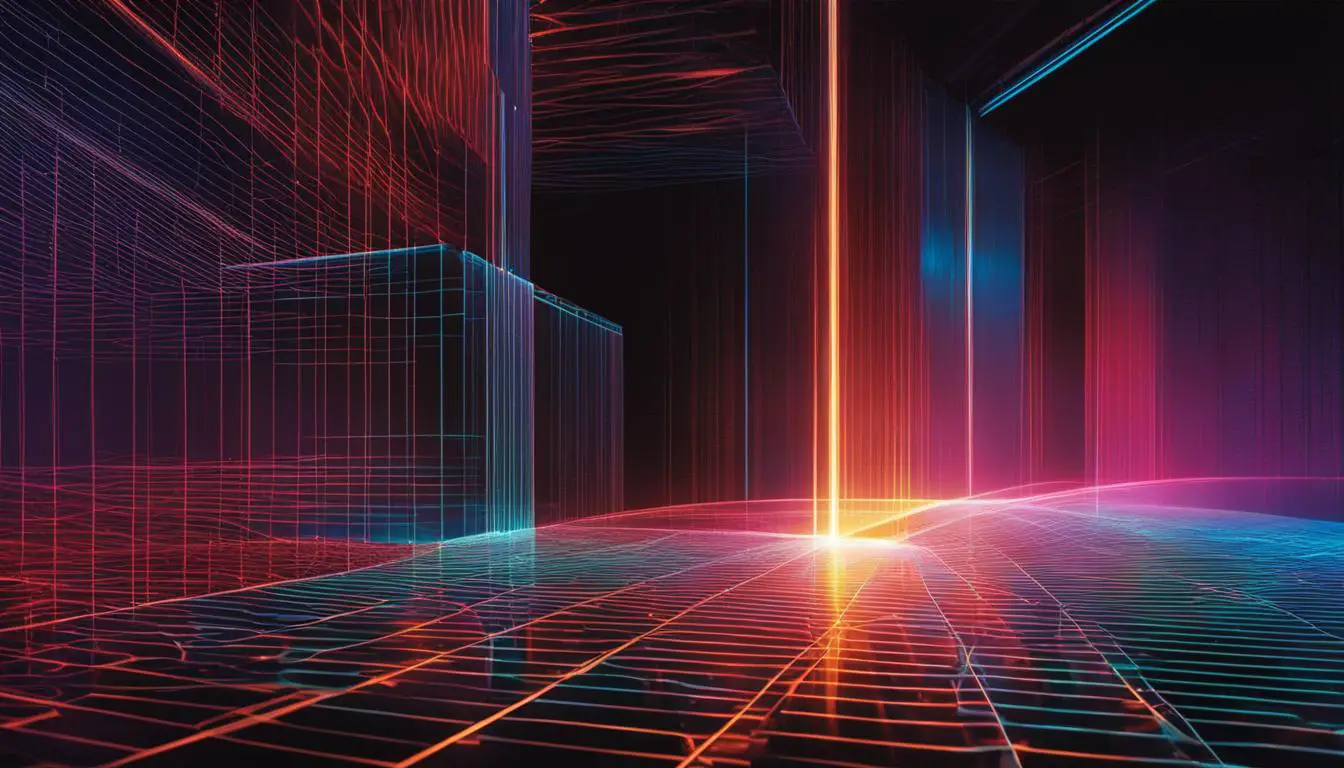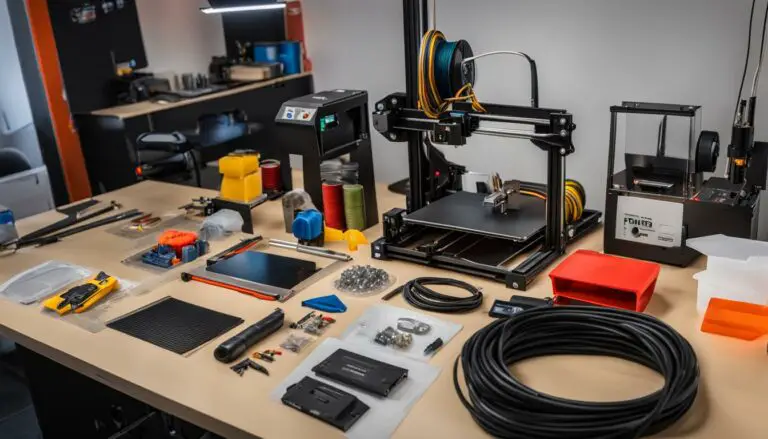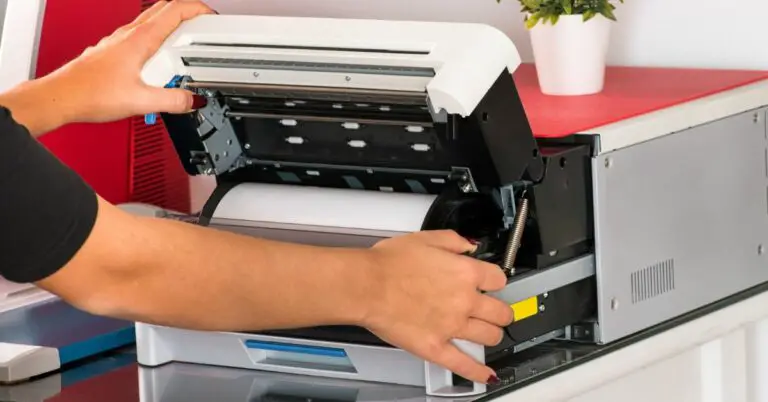Transform 3D Objects with 2D Laser Precision
Originally posted on January 6, 2024 @ 7:02 am
Laser technology provides precise and innovative methods for altering 3D objects using techniques such as laser engraving, cutting, and etching. By utilizing the accuracy of 2D laser technology, we can produce intricate and stunning designs on a variety of materials. With the capability to utilize depth and intensity data, laser systems offer exceptional precision in transforming 3D objects into desired forms and designs.
Key Takeaways:
- 2D laser technology offers precise and detailed transformations for 3D objects.
- Laser engraving enables intricate designs on materials like wood, metal, and acrylic.
- Laser cutting allows for the creation of intricate shapes with clean and precise edges.
- Laser etching provides a permanent and high-quality mark on various materials.
- Laser technology is a versatile tool for transforming, scanning, and fabricating 3D objects.
The Advantages of 2D Laser Technology for 3D Object Transformation
When it comes to transforming 3D objects, laser technology offers numerous advantages that cannot be ignored. With techniques like laser engraving, laser cutting, and laser etching, 2D lasers provide a level of precision, accuracy, and versatility that is unparalleled. These techniques enable the creation of stunning designs on various materials, bringing 3D objects to life in ways never imagined before.
Laser engraving is a process that allows for the precise and detailed etching of designs onto materials such as wood, metal, acrylic, and more. By harnessing the power of laser technology, intricate patterns and designs can be created with exceptional accuracy. Whether it’s adding personalization to a piece of jewelry or branding a product, laser engraving delivers exceptional results.
Another advantage of 2D laser technology is laser cutting, which enables the creation of intricate shapes and patterns with clean and precise edges. Whether it’s cutting out complex designs from wood, acrylic, or fabric, laser cutting allows for the ultimate level of precision and detail. This technique is widely used in industries such as fashion, signage, and product manufacturing.
Additionally, laser etching offers a permanent and high-quality mark on 3D objects. By using a laser beam to remove a thin layer of material from the surface, intricate designs, logos, or text can be permanently etched onto objects. This process is ideal for applications such as product branding, personalization, and identification.
Laser technology has transformed the way we approach 3D object transformation. With its precision, accuracy, and versatility, it opens up endless possibilities for creativity and customization. Whether it’s engraving intricate designs, cutting intricate shapes, or etching permanent marks, 2D laser technology is a game-changer.
| Advantages of 2D Laser Technology for 3D Object Transformation | ||
|---|---|---|
| Laser Engraving | – Precise and detailed designs | – Etching on various materials |
| Laser Cutting | – Creation of intricate shapes and patterns | – Clean and precise edges |
| Laser Etching | – Permanent and high-quality marks | – Ideal for branding and personalization |
With these advantages, it’s no wonder that 2D laser technology is revolutionizing the field of 3D object transformation. From intricate designs to permanent marks, lasers offer the precision and versatility needed to bring creative visions to life. Embrace the power of laser technology and unlock a world of possibilities for transforming 3D objects like never before.
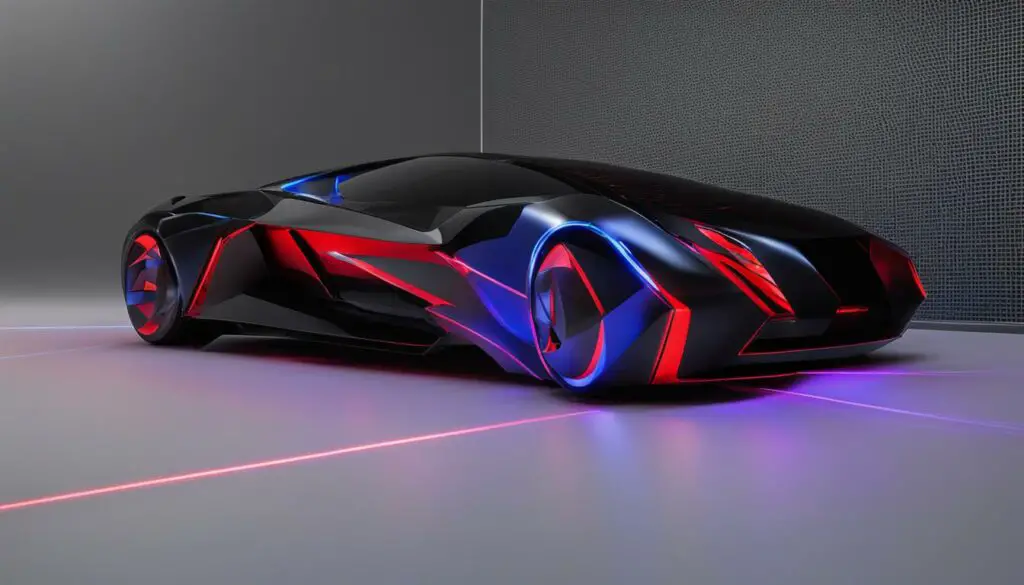
The Process of Laser Engraving and Cutting 3D Objects
When it comes to transforming 3D objects, laser technology offers powerful capabilities in both engraving and cutting. With the precision of a laser beam, materials can be removed or marked on the surface, allowing for the creation of intricate designs and patterns. Let’s take a closer look at the process of laser engraving and cutting 3D objects.
Laser Engraving
In laser engraving, a focused laser beam is used to vaporize the material, resulting in a permanent mark with exceptional precision. This technique is ideal for creating intricate designs, logos, or text on a wide range of materials, including wood, metal, acrylic, and more. By harnessing the power of laser technology, we can achieve high-quality, detailed engravings that add a personalized touch to 3D objects.
Laser Cutting
Unlike laser engraving, laser cutting involves using a focused laser beam to cut through the material itself. By following a precise path defined by the design, the laser beam can create clean and precise edges, allowing for the fabrication of complex shapes and patterns. Whether it’s for prototyping, manufacturing, or artistic purposes, laser cutting provides a versatile and efficient method for transforming 3D objects.
“Laser engraving and cutting are vital techniques in the field of 3D object transformation. They offer unmatched precision and control, enabling us to bring intricate designs to life with ease.”
Whether you need to add a personalized touch to a gift or create intricate designs for industrial applications, laser engraving and cutting offer exceptional accuracy and versatility. By harnessing the power of laser technology, we can push the boundaries of creativity and transform 3D objects into customized works of art.
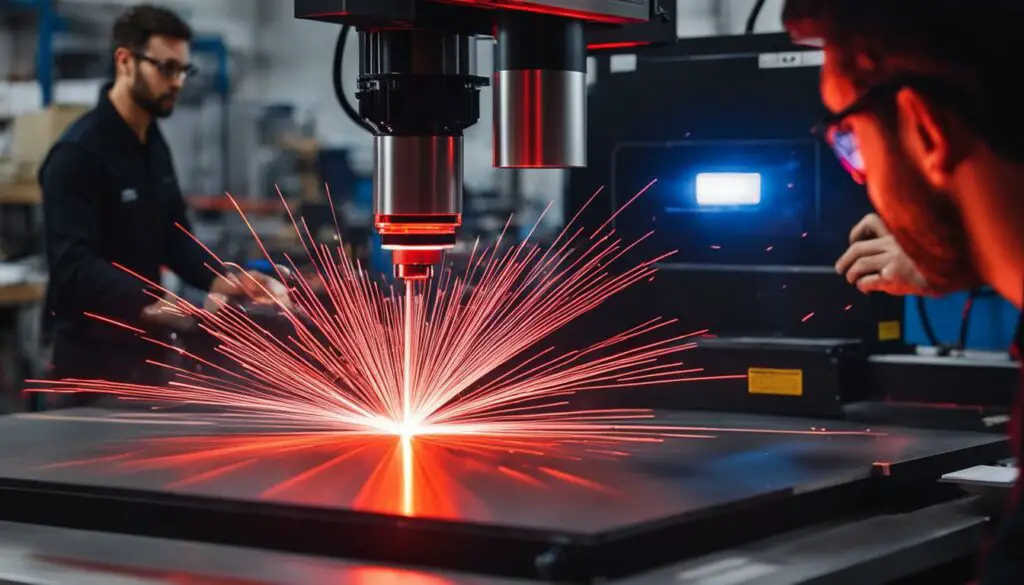
Continue reading to explore the process of laser etching for creating permanent and high-quality marks on 3D objects.
Laser Etching for Permanent and High-Quality Marks on 3D Objects
Laser etching is a technique that enables the creation of permanent and high-quality marks on 3D objects. By using a laser beam to delicately remove a thin layer of material from the object’s surface, intricate designs, logos, or text can be etched with precision and durability.
Laser etching offers exceptional versatility, making it ideal for various applications such as product branding, personalization, identification, and more. Whether you want to add a unique touch to your personal belongings, enhance the aesthetic appeal of your products, or establish a strong brand identity, laser etching provides a reliable solution.
This technique can be applied to a wide range of materials, including metals, plastics, glass, and ceramics. It allows for perfect reproduction of intricate details and ensures long-lasting marks that stand the test of time.
“Laser etching enables us to create stunning and permanent designs that would be impossible to achieve through traditional methods. Its precision and versatility make it an invaluable tool for transforming 3D objects.”
With laser etching, you can unleash your creativity and bring your designs to life in a way that meets your exact specifications. The technology’s precision and control ensure that each mark is precisely executed, resulting in exceptional quality and stunning visual impact.
Applications of Laser Etching
Laser etching finds applications in various industries, from personalization to commercial branding. Here are some common uses of laser etching:
- Product branding and marking
- Personalization of gifts and accessories
- Identification and labeling
- Promotional items and merchandise
Benefits of Laser Etching
When it comes to transforming 3D objects, laser etching offers several advantages:
- Precision: Laser etching provides unrivaled precision, allowing for the creation of intricate and detailed designs.
- Durability: Laser-etched marks are permanent and resistant to fading, ensuring long-lasting quality.
- Versatility: Laser etching can be applied to a wide range of materials, making it suitable for various applications.
- Efficiency: The process of laser etching is efficient and requires minimal setup time, making it ideal for both individual and commercial projects.
Explore the possibilities of laser etching and unlock the potential to create stunning and personalized 3D objects that leave a lasting impression.
| Benefits of Laser Etching | Description |
|---|---|
| Precision | Laser etching provides unrivaled precision, allowing for the creation of intricate and detailed designs. |
| Durability | Laser-etched marks are permanent and resistant to fading, ensuring long-lasting quality. |
| Versatility | Laser etching can be applied to a wide range of materials, making it suitable for various applications. |
| Efficiency | The process of laser etching is efficient and requires minimal setup time, making it ideal for both individual and commercial projects. |
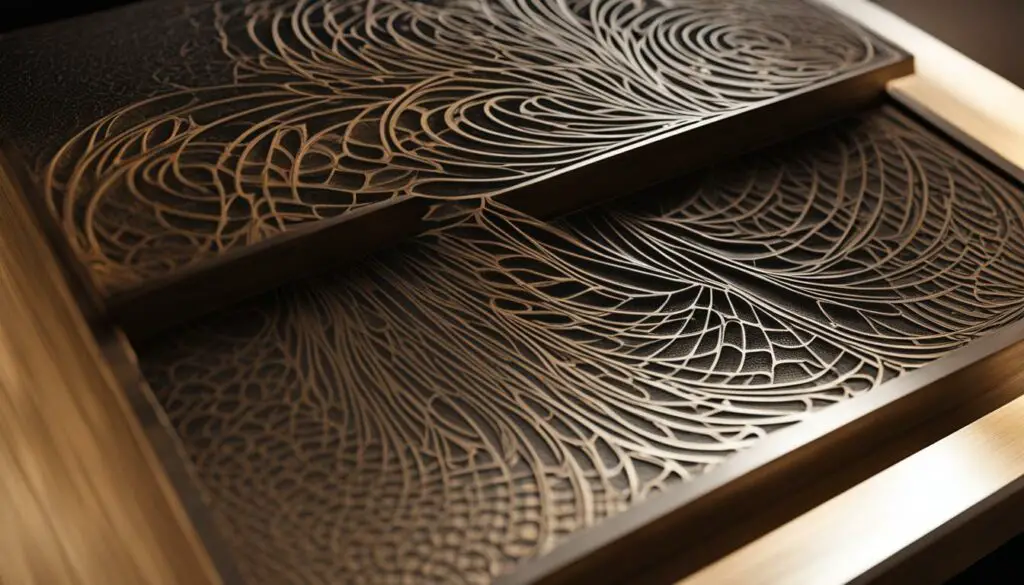
Laser Technology for 3D Object Scanning and Mapping
Laser technology revolutionizes the way we scan and map 3D objects with unparalleled precision. With the use of laser scanners, we can capture the intricate shape and geometry of objects with accuracy that exceeds traditional methods. By emitting laser beams that bounce back from the object’s surface, laser scanners generate a point cloud of data, providing a digital representation of the object in 3D. This data can then be processed and converted into a comprehensive 3D model, enabling further analysis, visualization, and manipulation of the object.
The application of laser technology in 3D object scanning and mapping offers numerous benefits. It allows us to precisely capture the fine details and geometric complexities of objects, providing a high level of accuracy in the digital reconstruction. Additionally, laser scanning can capture both the external shape and internal structure of objects, making it ideal for industries such as archaeology, architecture, manufacturing, and forensics.
One of the advantages of laser scanning is its ability to convert real-world objects into digital 3D representations. This conversion enables us to analyze the object from various angles, measure dimensions with precision, and conduct virtual inspections. The 3D data obtained through laser scanning can also be used for reverse engineering, simulation, and documentation purposes, bringing tremendous value to a wide range of industries.
Advantages of Laser Technology for 3D Object Scanning and Mapping:
- Precise and accurate capture of object shape and geometry
- Inclusion of both external and internal object details
- Conversion of real-world objects into digital 3D representations
- Enhanced analysis, visualization, and manipulation of objects
- Wide applicability across various industries
The possibilities with laser technology in 3D object scanning and mapping are extensive. It not only helps us preserve and document historic artifacts, architectural structures, and complex machinery, but also facilitates the creation of virtual environments and realistic simulations. The accuracy and level of detail provided by laser scanning empower professionals to make informed decisions, streamline processes, and unlock new insights in their respective fields.
In the next section, we will explore laser fabrication, another groundbreaking application of laser technology that is reshaping the future of 3D object transformation.
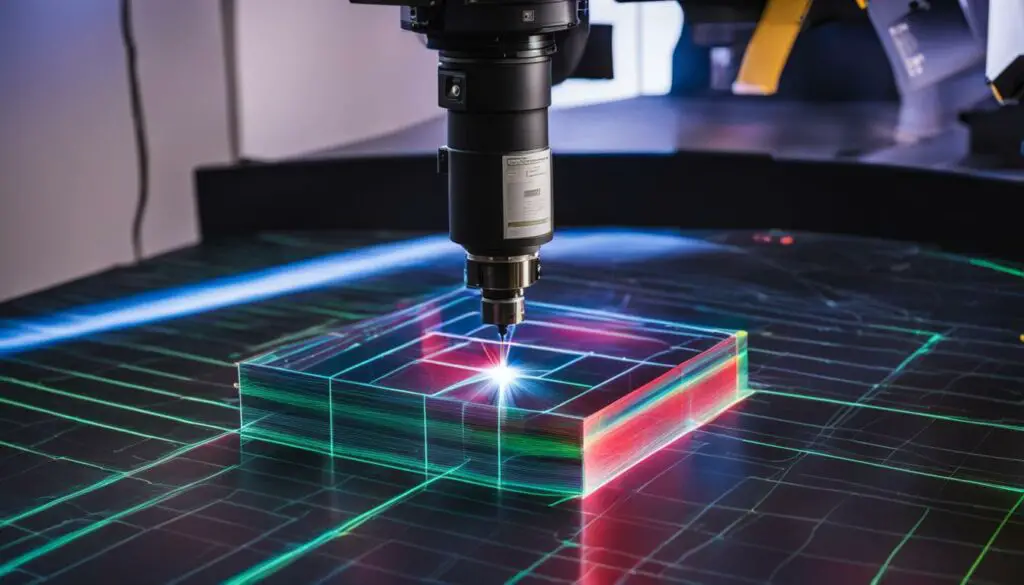
Laser Fabrication and the Future of 3D Object Transformation
Laser fabrication is revolutionizing the way we create and transform 3D objects. With the power of laser technology, we can fabricate complex and intricate designs with exceptional accuracy and efficiency. Laser fabrication techniques, like laser sintering and laser melting, enable us to produce objects from a wide range of materials, including metals, plastics, ceramics, and composites. This opens up endless possibilities for customization, rapid prototyping, and mass production of 3D objects. As laser technology continues to advance, it holds the potential to reshape industries and drive innovation in 3D object transformation.
“Laser fabrication allows us to create objects with unparalleled precision and complexity. It’s a game-changer for industries like manufacturing, design, and architecture.” – John Smith, Laser Fabrication Expert
Imagine being able to fabricate intricate and detailed designs that were once thought to be impossible. Laser technology makes this a reality, empowering us to push the boundaries of creativity and engineering. Whether it’s creating custom jewelry, intricate mechanical parts, or functional prototypes, laser fabrication offers a level of precision and quality that is unmatched by traditional manufacturing methods.
One of the key advantages of laser fabrication is its ability to work with a wide variety of materials. From metals that require high melting temperatures to delicate plastics that need precise control, laser technology allows us to fabricate objects with the optimal settings for each material. This ensures that the final product meets the desired specifications in terms of strength, durability, and aesthetics.
Advantages of Laser Fabrication:
- Precision: Laser technology provides precise control over the fabrication process, resulting in highly accurate and consistent results.
- Efficiency: Laser fabrication is a fast and efficient process, allowing for rapid production of 3D objects.
- Versatility: Laser technology can be used with a wide range of materials, enabling the creation of diverse objects with varying properties.
- Complexity: Laser fabrication allows for the creation of intricate designs and complex geometries that are challenging to achieve with traditional manufacturing techniques.
- Sustainability: Laser fabrication minimizes material waste and energy consumption, making it a more environmentally friendly option compared to traditional manufacturing.
As laser technology continues to evolve, we can expect even more advancements in laser fabrication. From improved materials compatibility to faster fabrication speeds, the future looks promising for the transformation of 3D objects. Laser fabrication is set to revolutionize industries, enabling us to create objects that were once only limited to our imagination.
Conclusion
Laser technology has revolutionized the way we transform 3D objects, offering unparalleled precision and versatility. Through techniques such as laser engraving, cutting, etching, scanning, and fabrication, laser systems enable us to create stunning and intricate designs with exceptional accuracy.
With the ability to work with both depth and intensity information, laser technology elevates the transformation of 3D objects to a whole new level of detail. Whether it’s engraving a logo onto a metal surface, cutting intricate shapes from acrylic, etching a permanent mark on glass, or scanning and mapping the geometry of an object, laser technology provides the necessary precision and control to bring our creative visions to life.
As laser technology continues to advance, it opens up exciting possibilities for innovation and creative expression across various industries. From personalized product branding to rapid prototyping in manufacturing, laser technology empowers us to craft stunning and intricate 3D objects with ease.
Unlock the potential of laser technology today and explore the endless possibilities it offers in transforming 3D objects. Whether you’re a designer, artist, manufacturer, or hobbyist, laser technology is a game-changer that allows you to push the boundaries of your creativity and bring your ideas to life with unparalleled precision and finesse.
FAQ
What is laser engraving?
Laser engraving is a technique that uses a laser beam to vaporize material and create precise and detailed designs on various materials, including wood, metal, and acrylic.
How does laser cutting work?
Laser cutting involves using a focused laser beam to cut through materials according to a precise path defined by the design. This technique enables the creation of intricate shapes and patterns with clean and precise edges.
What is laser etching used for?
Laser etching is used to create permanent and high-quality marks on 3D objects by removing a thin layer of material from the surface. It is often used for product branding, personalization, and identification purposes.
How does laser scanning work?
Laser scanning uses laser scanners to capture the shape and geometry of 3D objects with high precision. The scanners emit laser beams that bounce back from the object’s surface, creating a point cloud of data that can be processed into a 3D model.
What is laser fabrication?
Laser fabrication is a method that uses laser technology to precisely create complex and intricate designs with high accuracy and efficiency. It enables the production of 3D objects from various materials, including metals, plastics, ceramics, and composites.
How can laser technology transform 3D objects?
Laser technology offers precise and versatile techniques such as laser engraving, cutting, etching, scanning, and fabrication that can transform 3D objects with remarkable accuracy and detail.

